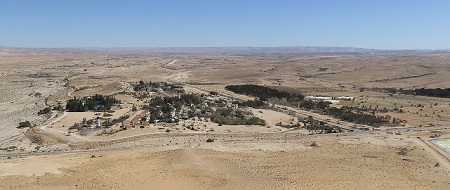It is not Mary's tomb!
Publish date 23-05-2021
 On January 6, the Israel Antiquities Authority announces a fortuitous discovery within the Nizzana National Park. Following maintenance work on a park path, David Palmach, the director of the Nizzana Educational Village , found an inscribed circular stone at the start of the track. Palmach immediately contacted the relevant authorities and the find was transferred to the National Treasuries Dept.
On January 6, the Israel Antiquities Authority announces a fortuitous discovery within the Nizzana National Park. Following maintenance work on a park path, David Palmach, the director of the Nizzana Educational Village , found an inscribed circular stone at the start of the track. Palmach immediately contacted the relevant authorities and the find was transferred to the National Treasuries Dept.
What was it about? The inscription, which was decrypted by Dr. Leah Di Segni, of the Hebrew University of Jerusalem, referred to "Blessed Mary, who lived an immaculate life". The stone also bears the date of her death: February 9.
So was the tomb of Mary, the mother of Jesus found? No, in fact the tombstone has been dated, on an epigraphic basis, to the end of the 6th, beginning of the 7th century AD.
The site of the discovery, however, is of some importance. According to Tali Erickson-Gini of the IAA, Nizzana "had a military fortress, churches, a monastery and a post office for Christian pilgrims traveling from Santa Katarina."
The settlement of Nizzana (or Nitzana) was founded by the Nabataeans, as a caravanserai on the way to Arabia and the spice and incense trade. In the Byzantine period it became a regional center, maintaining its function as a stopping point on the routes of pilgrims. Finally, when the area was conquered by the Arabs and the commercial lines also changed, the site underwent a phase of abandonment.
The site is also famous for a collection of papyri, found during excavations in 1930. There are 195 fragments, dated between the 6th and 7th centuries, which testify to the transition from the Byzantine to the Arab phase. The texts, found in two city churches, tell the daily and religious life of the Nabataean inhabitants of the site.
The tombstone is probably part of the Christian cemetery that surrounded the city and of which little is known, as it has not been excavated. For this reason, according to the archaeologist Pablo Betzer "the discovery of any inscription like this can broaden our knowledge of the boundaries of the cemetery, which helps us to reconstruct the boundaries of the settlement itself, which have not yet been ascertained".
Agnese Picco
NP February 2021







